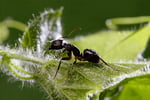1. Avoid Overwatering
Mushrooms in lawns are often a sign of overwatering, which means water is also being wasted. Recalculating the watering needs of your grass will help to ensure your lawn stays green while clusters of mushrooms remain unable to grow. Check your drip systems and sprinkler heads for signs of trouble.
2. Make Room for Sun
You may want to consider trimming away branches and undergrowth that prevent the sun from penetrating to the soil or keep the area damp. Removing these excess structures will open your yard up for healthier grass growth while still protecting you from the sun’s heat.
3. Dethatch, Aerate, and Remove Clippings
Dense, thick soils and grass with a significant thatch layer make perfect homes for mushroom structures to grow. Make sure you’re raking your lawn often and removing the dead layer underneath. Lawn aeration will help to prevent soil from condensing and opens up the earth for more oxygenation and sunlight. When you mow, make sure to remove grass clippings to eliminate a possible food source and the accumulation of debris.
4. Use a Slow Release, Nitrogen Rich Fertilizer
Mushrooms in lawns can deplete your soil of important nutrients. Adding a regular, slow release fertilizer to your lawn care routine will help to ensure your lawn has all the vital nutrients it needs to root deeper and continue to thrive, should mushrooms appear.









































